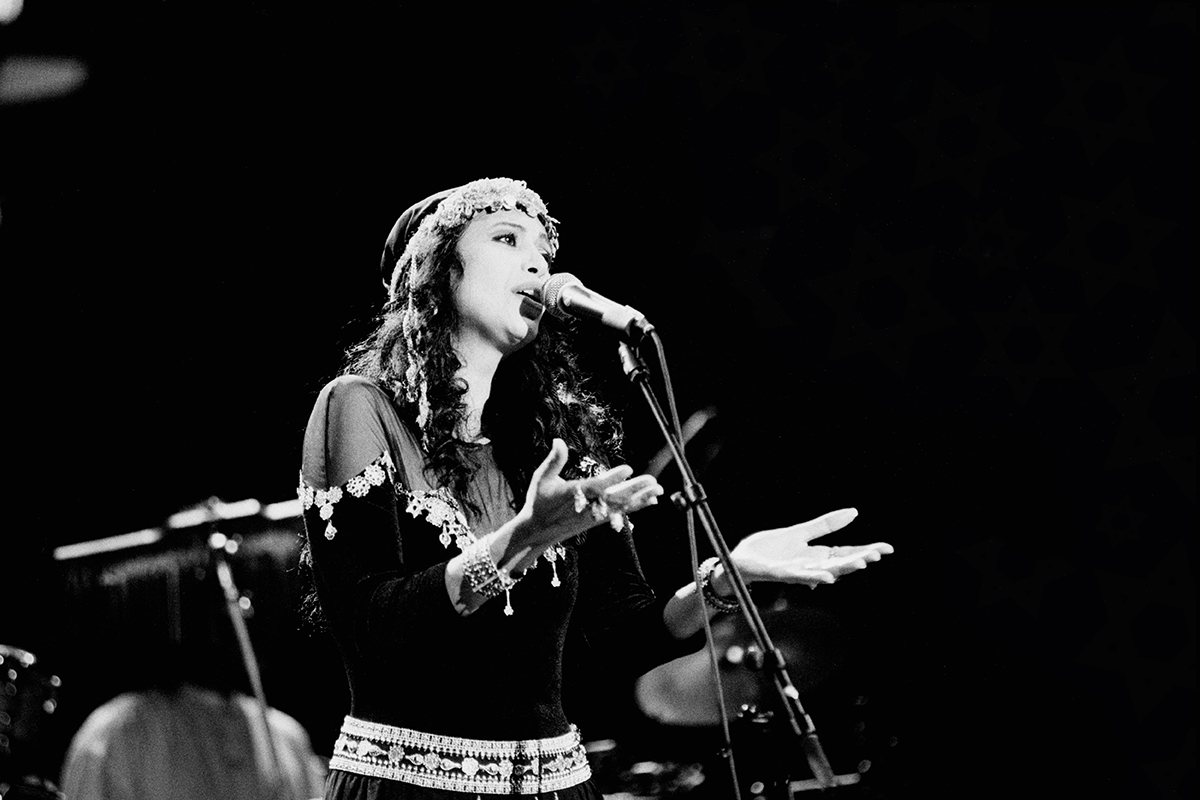When I met Kornelia Binicewicz outside a boutique cafe near her home, she wore a plaid coat and a winter hat to fend off the characteristic chill of the winter lodos wind off the Sea of Marmara. She lives on Burgazada, one of the Prince Islands off the coast of Istanbul. Working in collaboration with the Israeli consulate in Istanbul, Binicewicz exudes the fun, spunky rhythms of the project that brought her to this island.
Binicewicz, a Polish record collector, came to Turkey to put her perspicacious ear for its regional music history to use. She had trained for this by working for eight years as a curator of Krakow’s Jewish Festival, seen by many as the most important Jewish event in the world. “My interest in Israeli music is an outcome of my work as an anthropologist of culture, exploring the connections between cultures,” Binicewicz tells Alma. “Working for the festival exposed me to the multiculturalism of Israel, and the Middle East.”
Her project, Ladies on Records, grew out of her fascination with female singers from around the world, most recently Turkey and the Middle East. When the pandemic caused her work as a DJ to grind to a halt, she returned to research and writing, excavating the unwritten history of Turkish-Israeli overlaps in Middle Eastern pop music. Within the frame of Ladies on Records, she is showcasing Turkish and Israeli women who drew from traditional Middle Eastern sounds through the release of physical and digital compilations, as well as stories about the artists themselves.
Modernization politics have tended to minimize Turkey and Israel’s traditional shared heritage, especially as each country has tried to form its national identity. But as Turkey approaches its centennial — and with Israel just a few decades behind — Binicewicz is trying to re-establish these ties, one listener at a time.
She hears Israeli music in the regional fusions of Anatolian rock, which European listeners often mistakenly categorize as a form of psychedelia in Turkey. In fact, as Binicewicz learned through voracious listening, Turkish music has an unsung history of shared cultural affinities, from Istanbul to Tel Aviv, Cairo to Beirut.
“I established Ladies on Records as a label and brand to focus on excavating music that was created by women, and telling their stories in a different way, to shed new light on music created by women,” Binicewicz says. “In Poland, I realized there’s so little information in what I was interested in: female artists from Turkey. So I quit my job and came to Turkey. After one month, I bought 250 records.”
Over the winter, on the Marmara island she calls home, she focused Ladies on Records on a specific subset of Israeli-Turkish crossover music, which she titled “A Drop of Luck,” a reference to the 1988 Hebrew song “Tipat Mazal” by Mizrahi Israeli singer Zehava Benlt.
Binicewicz began to trace which Israeli singers borrowed from Turkish singers, and vice versa. There are melodies, rhythms, and lyrics in Mizrahi Israeli songs that are exactly the same in Arabesque Turkish music, a genre that is generally stereotyped as part of Turkey’s more eastern, country, or folk heritage, suffused with Arabic motifs, minor keys and ululating vocals, string sections, and traditional percussion. “Arabesque is a music that is said to have come into existence in the 1970s. But Arabesque has always been in the Anatolian spirit, and in the Anatolian way of making music. It’s based on traditional songs, folk songs. It’s influenced by Arabic, and Egyptian music, and also consists of influences from all around the world. It’s a good example of fusion or world music,” Binicewicz says.
These “twin” songs include some of the biggest hits in their respective countries. After Israeli star Ofra Haza sang “Im Nin’alu” (“If Locked”), based on a 17th century Yemenite liturgical poem, Zerrin Özer, the Janis Joplin of Turkish music, fronted its remix, the Turkish hit “Hani Yeminin?” (“What About Your Promise?”) in 1988.
Binicewicz has created two mixtapes which tell the story of this interchange between Turkish Arabesque and Mizrahi Israeli music, under the titles “Adaptations” and “Sources.” They include songs that reach back to the late 1950s, and continue up through the last decade.
In the 1960s, the Israeli duo HaDuda’im toured the world, including Istanbul, headlining with the song “Erev Shel Shoshanim” (“Evening of Roses”) as their hit, at the time a classic wedding song. In Turkish, the same song takes on an electronic allure, stripped of its folkloric loftiness. Gönül Turgut’s deep, smoky voice contrasts with her blonde bombshell look, conveying the bold aesthetic of an early Bond film. The songs of Binicewicz’s first playlist, “Sources,“ begins with the 1957 Israeli production of “Erev Shel Shoshanim” by Yafa Yarkoni, which parallels the 1969 Turkish “Uzat Artık Elini” (“Extend Your Hand Now”) by Gönül Turgut on her second playlist, “Adaptations.”
According to her research, Zehava Ben’s “A Drop of Luck” was adapted from “Dil Yarası” (Tongue Wound) by Orhan Gencebay, considered by some to be the father of Arabesque music. Binicewicz decided to include male singers like him and Zeki Muren, who dressed as a woman and opened the field for gay and transgender artists in Turkey, in Ladies on Records as context: Though she’s emphasizing female singers, the genre is historically male-dominated. Binicewicz stresses that though Arabesque and Mizrahi music did provide a space for female singers, it was never feminist.
“I would never say that Arabesque has anything in common with women’s liberation, quite the opposite,” Binicewicz says. “The lyrics of Arabesque are full of fatalism, very, very dark. The genre is extremely patriarchal. It’s designed by men, played by men. Women have been performers, but are very objectified, and played very classically, objectified roles in this music. I wouldn’t say that Arabesque artists are messengers of anything more than the suffering of men and women. It was not a voice of any freedom.”
As an example, Binicewicz mentioned the Turkish Arabesque singer Bergen, who appears on the cover of her later records with ‘80s-style curls covering the left side of her face because her ex-husband had poured nitric acid on her, blinding her in one eye. When she was 31, while on tour, she was fatally wounded when he shot her six times. The tragic nature of her life, Binicewicz would say, is very Arabesque.
Arabesque and Mizrahi singers also sprang from a bygone climate of copyright lawlessness. Until 1986, artists in Turkey and Israel were free to mix and match each other’s music, borrowing at will. That history of fusion is clear in the Eastern instrumentation, vocalization, and aesthetic, born out of a cultural milieu, as Israel was formerly Ottoman territory, and, like Turkey, includes and borders Arab nations.
The 1960s and ‘70s especially marked a heyday in Turkish-Israeli cultural exchange through popular music, and a reconciliation of Arabic and Middle Eastern influences, which reflected the sociopolitical climate of the time.
“I came here to Turkey and I knew that the Jewish community has been so vivid here for thousands of years. I was shocked by how difficult it was to talk about Israel. Stating that something was Israeli was politicized, difficult. Jews in Turkey are hidden,” Binicewicz shares.
Prior to the 2000s, before the current political regime in Turkey bolstered Islamic nationalism in the Middle East, Arabesque music could more directly connect with Mizrahi minorities in Israel, in their confrontations with Westernization. Now, there is a rift between Turkey and Israel, a silencing tension that has obscured the cultural ties and shared history of Mizrahi and Arabesque singers.
“These issues are discussed in Israel. In Turkey, this is a secret topic. This government created a polarization of people. Arabesque is this borderline. It shows where you belong,” Binicewicz says. “Conservative people in Turkey are still fighting Western secularism. People don’t want to talk about it, Arabesque and Arab culture.”
Today, younger Turks steeped in pop music often look back at the Arabesque genre with disdain and mockery. Its sound has been co-opted by Islamist politicians among Turkey’s ruling party as a soundtrack of the populist agenda. And the Israeli legacy of Mizrahi cultural struggle continues as music no longer echoes between Turkey and Israel. Turkish and Israeli singers used to tour frequently between Tel Aviv and Istanbul; now, that once-vibrant mutual sphere of influence is no more.
“Mizrahi cannot be defined in terms of nationality or ethnicity. It contains so many people, from Iraq, Greece, Portugal, Italy, Turkey,” Binicewicz says. “This is about cultural connections that go unnoticed. Borrowing from each other to define identity. It is not only the pleasure of listening, but the pleasure of learning.”



